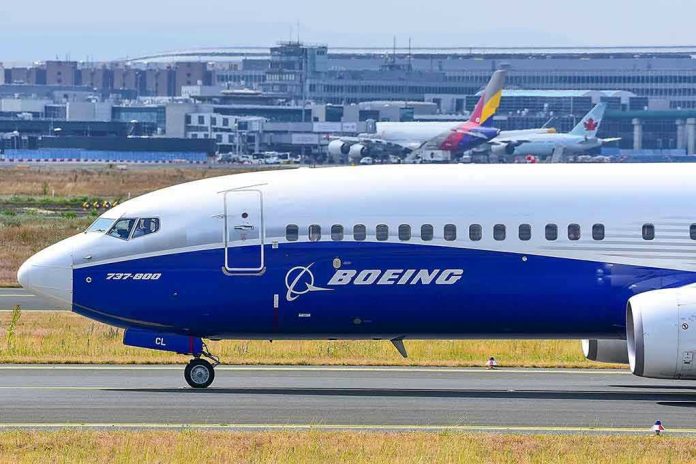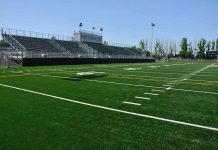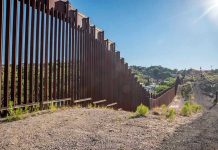
The four Alaska Airlines flight attendants suing Boeing over the 737 MAX 9 mid-air panel blowout are drawing national attention to ongoing safety and manufacturing concerns at one of America’s largest companies, highlighting issues that persisted under the previous administration and raising serious questions about accountability in American industry.
Story Snapshot
- Four Alaska Airlines flight attendants filed lawsuits against Boeing after a dramatic mid-air panel blowout aboard Flight 1282 in January 2024
- The lawsuits focus on Boeing’s manufacturing quality, crew safety, and the broader implications for aviation safety and corporate accountability
- The incident triggered a global grounding of the 737 MAX 9 fleet and renewed scrutiny of Boeing’s practices
- Regulatory agencies and the public are demanding answers and reforms after years of what many see as lax oversight and corporate cost-cutting
Flight Attendants Take Boeing to Court Over MAX 9 Panel Blowout
Four Alaska Airlines flight attendants have launched lawsuits against Boeing, seeking compensation for injuries and emotional trauma after the harrowing mid-air panel blowout on a 737 MAX 9 in January 2024. The panel—actually a “door plug” used to seal an unused emergency exit—blew out at 14,830 feet shortly after takeoff from Portland, Oregon, causing rapid decompression and forcing the crew into emergency procedures. While there were no fatalities, both passengers and crew suffered minor injuries. For the four flight attendants, the ordeal has led to ongoing physical and emotional harm, forming the core of their legal case against the aircraft manufacturer. Their lawsuits cite not only immediate injuries but also the long-term financial and psychological impact of the incident.
Boeing sued by flight attendants over MAX 9 mid-air panel blowout https://t.co/vDJ9vvxAEF https://t.co/vDJ9vvxAEF
— Reuters (@Reuters) August 1, 2025
Unlike many previous aviation lawsuits, these legal actions come from crew members rather than passengers. This focuses the nation’s attention on occupational safety, shifting the debate from customer risk to the working conditions of those responsible for passenger safety every day. It also raises the stakes for Boeing, as the company must now defend its practices not just to the flying public, but also to the professionals who keep America’s skies safe.
The Incident and Its Aftermath: Timeline and Regulatory Response
The panel blowout aboard Alaska Airlines Flight 1282 on January 5, 2024, was immediately followed by swift action from Alaska Airlines and the Federal Aviation Administration (FAA). Alaska Airlines grounded its entire MAX 9 fleet within hours, and the FAA issued an Emergency Airworthiness Directive grounding all U.S.-operated MAX 9s fitted with similar door plugs. The National Transportation Safety Board (NTSB) and FAA launched investigations, with global regulators quickly following suit. Investigators soon discovered missing bolts and possible lapses in Boeing’s manufacturing and quality controls. The repercussions were immediate and global: airlines worldwide removed MAX 9s from service until they could be inspected and deemed safe. The episode reignited concerns about Boeing’s quality assurance after the MAX series’ troubled history, which included two catastrophic crashes in 2018 and 2019 and a subsequent worldwide grounding. The 2024 incident, while not fatal, underscored persisting doubts about oversight, cost-cutting, and the true state of American manufacturing leadership.
The MAX 9 fleet eventually returned to service after extensive inspections and regulatory review, but scrutiny remains high. The FAA and NTSB have both reaffirmed their commitment to transparency and safety, and investigations into Boeing’s practices continue. As of August 2025, Boeing has not publicly commented on the lawsuits, but the potential legal and financial ramifications are significant.
Industry Accountability and the Push for Reform
The lawsuits filed by the crew—who are trained to handle emergencies and protect lives—bring a new dimension to the ongoing debate about aviation safety and corporate responsibility. Legal analysts note that crew-initiated litigation is rare and could set new precedents for occupational safety claims in the airline industry. Aviation safety experts emphasize the seriousness of the incident, noting that in-flight structural failures are exceedingly rare and highlight the need for robust quality control at every level of production and oversight. Academic and industry commentators have pointed to systemic problems at Boeing, including lapses in internal checks and the challenges of balancing innovation, safety, and profit. Some have argued that regulatory capture and an emphasis on cost reduction, particularly during the previous administration, contributed to an environment where critical safety issues were overlooked or minimized. For many Americans, these lawsuits and ongoing investigations represent a necessary stand for accountability, transparency, and the protection of American workers and travelers. They serve as a stark reminder of the dangers of government overreach—or underreach—when it comes to regulating industries that touch the lives of millions.
The economic, social, and political stakes are high. Boeing faces the prospect of further litigation, potential settlements, and ongoing reputational damage. The aviation industry as a whole could see tighter regulations and new protocols aimed at preventing similar incidents. For the flying public and the crews who serve them, renewed attention on safety and accountability is both overdue and essential to restoring trust in a critical American sector.
Broader Implications: Safety, Public Trust, and the American Way Forward
The Alaska Airlines MAX 9 incident has become a flashpoint in the national conversation about corporate responsibility, regulatory oversight, and the duty to protect American families and workers. While the lawsuits are still in their early stages and the full impact remains to be seen, the message is clear: Americans demand accountability from those who build and regulate the machines on which so many lives depend. As legal proceedings unfold and investigations continue, the outcome will likely influence not just Boeing’s future, but also the standards by which all American manufacturers are judged. For a nation frustrated by years of lax oversight, government mismanagement, and the erosion of trust in institutions, these lawsuits represent a critical test of whether the system will defend the rights, safety, and prosperity of its people.
For conservative Americans who value freedom, transparency, and the rule of law, these developments are a reminder of the need for constant vigilance, honest leadership, and a steadfast commitment to the principles that built this country. The call for accountability in the wake of the MAX 9 blowout is about more than one company or one incident—it’s about defending American values and ensuring that government and industry serve the people, not the other way around.
Sources:
Wikipedia: Alaska Airlines Flight 1282
NTSB official investigation page
KIRO7 News: Boeing faces new lawsuits
The Straits Times: Flight attendants sue Boeing













